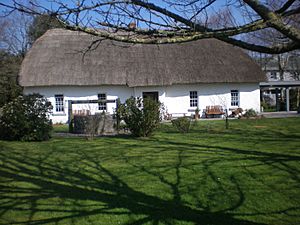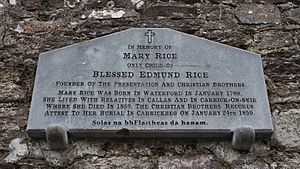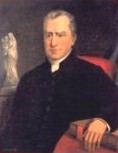Edmund Ignatius Rice facts for kids
Quick facts for kids BlessedEdmund Ignatius Rice F.P.M., CFC |
|
|---|---|
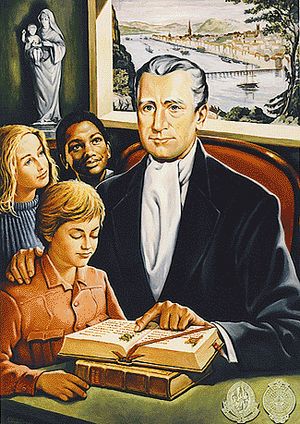 |
|
| Religious, Founder, Missionary, Educator | |
| Born | 1 June 1762 Callan, Ireland |
| Died | 29 August 1844 (aged 82) Waterford, Ireland |
| Venerated in | Catholic Church |
| Beatified | 6 October 1996, Vatican City by Pope John Paul II |
| Major shrine | Westcourt, Callan, Ireland International Heritage Centre, Mount Sion, Waterford, Ireland |
| Feast | 5 May |
| Attributes | Irish Christian Brothers' Black Habit |
Edmund Ignatius Rice (born June 1, 1762 – died August 29, 1844) was an important Catholic leader. He dedicated his life to helping others. He started two groups of religious brothers: the Congregation of Christian Brothers and the Presentation Brothers. These groups focus on education.
Edmund Rice was born in Ireland when Catholics faced many challenges. Laws called Penal Laws made it hard for them to get an education or own land. Even with these difficulties, Edmund built a successful business career. Later, a sad accident changed his life. His wife died, and his daughter was born with disabilities. After this, he decided to use his life and wealth to educate poor children.
Today, schools around the world, like the Christian Brothers and Presentation Brothers schools, still follow Edmund Rice's ideas. They continue his mission of helping young people learn and grow.
Contents
Early Life and Challenges
Edmund Rice grew up on a farm called "Westcourt" in Callan, County Kilkenny, Ireland. He was one of seven sons. He also had two older half-sisters from his mother's first marriage.
Getting an education was tough for Irish Catholics back then. A law from 1709 made it illegal to teach the Catholic faith. This meant many schools had to be secret, often held outdoors, called hedge schools. Edmund and his brothers learned at home from a kind Augustinian friar named Patrick Grace. He also spent two years at a school in Kilkenny City. The authorities allowed this school to exist, despite the strict laws.
When he was 17, Edmund moved to Waterford to work for his uncle Michael. His uncle had a business trading livestock and other goods. Edmund learned a lot about business and managing supplies for ships. When his uncle died in 1785, Edmund took over the successful company. He was also very active in helping the poor. He especially liked visiting sick people in their homes.
Around 1785, Edmund got married. We don't know much about his wife, but her name might have been Mary Elliott. Sadly, she died in January 1789 after an accident. She was pregnant at the time, and a daughter, also named Mary, was born just before her mother passed away. His daughter Mary was born with disabilities. Edmund was left a widower with a baby who needed special care.
Starting His Mission
After his wife's death, Edmund thought about becoming a monk. One day, while talking to a bishop's sister, a group of poor, ragged boys walked by. She pointed to them and said, "Why would you hide away in a monastery when you could help these poor young people?" This made Edmund think deeply about his purpose.
In 1802, Edmund decided to act. He sold his successful business. He opened a small school in a converted stable in Waterford. The first teachers found the children very difficult to manage and soon quit. This made Edmund realize he needed special teachers. He decided to train people who would dedicate their lives to teaching these children for free. His classes became so popular that he had to open another temporary school nearby.
A big moment came when two young men, Thomas Grosvenor and Patrick Finn, joined him. They wanted to join a religious group and decided to stay and teach at Edmund's school. The success of these early schools led to building a more permanent place. Construction began on June 1, 1802, for a building called "Mount Sion". It was officially blessed in 1803. At first, Edmund and the teachers lived at Mount Sion but walked to the other schools. In 1804, the new school building at Mount Sion opened, and all the students moved there.
With help from his friends, Edmund even got permission from the local Protestant bishop to open his schools. By 1806, Christian schools were open in several towns in Ireland.
Founding the Christian and Presentation Brothers
In 1808, seven of the teachers, including Edmund Rice, made religious promises under the local bishop. They followed the example of the Presentation Sisters, a group of women who also helped the poor. So, they were first called Presentation Brothers. This was the first group of religious men started in Ireland by someone who wasn't a priest. Edmund and his brothers worked hard, not just teaching, but also feeding and clothing the poor boys of Waterford. Their work changed the lives of many children. Soon, bishops from other parts of Ireland sent men to Edmund to be trained as teachers. This helped the Presentation Brothers spread across Ireland.
However, there was a problem. Each group of brothers was controlled by the local bishop, not by Edmund. This made it hard to move brothers to different schools where they were needed most. Edmund wanted the group to be recognized by the Pope. He wanted a "Superior General" who could lead all the brothers. In 1820, Pope Pius VII agreed to his request. The Pope said the brothers should promise to obey, live simply, and teach boys for free, especially the poor. The leaders of the houses would choose a Superior General. Edmund was chosen for this role from 1822 to 1838. This allowed him to send brothers to different areas where they were needed. During this time, the schools also expanded to England and began teaching more advanced subjects.
In the 1820s, the group grew so much that it became two separate groups: the Christian Brothers and the Presentation Brothers. The Christian Brothers chose a motto: "The Lord has given, and the Lord has taken away; blessed be the name of the Lord forever."
In 1828, Edmund Rice helped establish a new school and headquarters in Dublin. The politician Daniel O'Connell laid the foundation stone. Edmund lived in this building for several years starting in 1831.
Later Years and Passing
In February 1838, Edmund Rice left Dublin and returned to Mount Sion in Waterford. He was 76 years old and not in good health. He called for a meeting to choose a new Superior General. On July 24, 1838, Michael Paul Riordan was elected to take Edmund's place.
From then on, Edmund spent most of his time at Mount Sion. He continued to show great interest in the students and teachers. He would take short walks each day, but his arthritis became very painful. The community bought him a wheelchair to help him get around. By Christmas 1841, Edmund's health worsened. He was often confined to his room.
After being in a very weak state for over two years, Edmund Rice passed away at 11 a.m. on August 29, 1844. He died at Mount Sion, Waterford, where his body rests today. Large crowds gathered to honor him.
Becoming a Blessed Saint
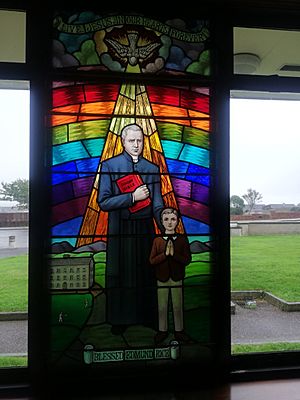
The first steps to make Edmund Rice a saint began in 1911. However, not much progress was made at first. Later, a Superior General named Pius Noonan, with help from Giovanni Battista Montini (who later became Pope Paul VI), officially started the process in Dublin in 1957.
In 1976, the Church in Dublin suggested that Edmund's case be sent to Rome. The Holy See (the Pope's main office) agreed to investigate. Three brothers worked hard to gather information and evidence from archives to show why Edmund should be declared a saint.
After all the investigations, on April 2, 1993, Pope John Paul II declared Edmund Rice to be "venerable". This means he was recognized for living a life of great virtue. Two years later, the same Pope approved a miracle attributed to Edmund Rice.
The miracle happened in 1976. A man named Kevin Ellison was very sick and doctors thought he only had 48 hours to live. A friend, Christian Brother Laserian O'Donnell, gave Kevin's parents a relic of Edmund Rice. Many people prayed for a miracle. The relic was placed by Kevin's bedside. Kevin survived, and doctors later found that his body had healed in an amazing way.
These events led to Edmund Rice being declared "Blessed" by Pope John Paul II on October 6, 1996. His official feast day is May 5.
A small piece of his kneecap is kept in a special container at St. Joseph's College in Stoke-on-Trent, England. This school is part of the "Edmund Rice family of schools," which follows his inspiring ideas.
See also
In Spanish: Edmund Ignace Rice para niños


